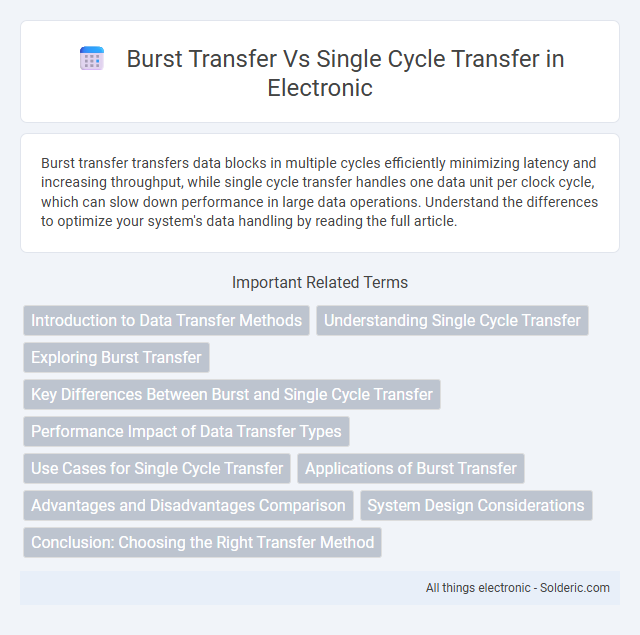Burst transfer transfers data blocks in multiple cycles efficiently minimizing latency and increasing throughput, while single cycle transfer handles one data unit per clock cycle, which can slow down performance in large data operations. Understand the differences to optimize your system's data handling by reading the full article.
Comparison Table
| Feature | Burst Transfer | Single Cycle Transfer |
|---|---|---|
| Definition | Multiple data units transferred in a continuous sequence without interruption. | One data unit transferred per clock cycle. |
| Data Throughput | Higher throughput due to continuous data flow. | Lower throughput, limited to single data per cycle. |
| Latency | Initial latency to start burst but efficient afterward. | Minimal latency, but less efficient for large data. |
| Use Case | Ideal for high-speed memory and cache transfers. | Used in simple, low-data-rate communications. |
| Complexity | More complex control logic required. | Simple control logic. |
| Power Consumption | Potentially lower power per data unit due to efficient bursts. | Higher power consumption per data unit. |
Introduction to Data Transfer Methods
Burst transfer sends multiple data units continuously over a communication channel, significantly increasing data throughput compared to single cycle transfer, which transmits one data unit per cycle. This method reduces overhead by minimizing control signal toggling and latency between transfers, making it highly efficient for large data blocks. Your system's performance can improve dramatically by leveraging burst transfer techniques in memory and peripheral interfaces.
Understanding Single Cycle Transfer
Single cycle transfer involves moving data between devices within one clock cycle, optimizing speed and reducing latency in synchronous systems. This transfer mode benefits applications requiring rapid, low-overhead communication but may be less efficient for large data blocks compared to burst transfer. Understanding the timing and control signals of single cycle transfer is crucial for designing high-performance microprocessor interfaces and memory systems.
Exploring Burst Transfer
Burst transfer improves data throughput by sending multiple data units in a continuous stream without repeated address phases, reducing overhead compared to single cycle transfer's one data unit per address cycle approach. This method enhances memory and peripheral device efficiency, particularly in high-speed bus architectures like AMBA or PCI Express. You benefit from decreased latency and optimized bandwidth when utilizing burst transfers for large or continuous data blocks.
Key Differences Between Burst and Single Cycle Transfer
Burst transfer involves sending multiple data units in a continuous sequence without repeated address phases, increasing system throughput and reducing overhead compared to single cycle transfer which transmits one data unit per clock cycle with separate address and data phases. Single cycle transfer, also known as single shot transfer, offers simplicity and reduced latency per individual transfer but is less efficient for large data blocks due to repeated address signaling. Burst transfer enhances performance in high-bandwidth applications by minimizing bus arbitration and control signal overhead, making it ideal for memory and streaming data operations.
Performance Impact of Data Transfer Types
Burst transfer significantly improves system efficiency by transferring multiple data words in a single continuous transaction, reducing bus turnaround times and maximizing throughput. In contrast, single cycle transfer handles one data word per cycle, introducing more bus arbitration and overhead, which can decrease overall performance during large data movements. Your system benefits from burst transfers when high-speed, low-latency data exchange is critical, especially in memory-intensive applications.
Use Cases for Single Cycle Transfer
Single cycle transfer is ideal for applications requiring predictable, low-latency data movement, such as real-time signal processing and simple control systems. Your system benefits from single cycle transfers when handling small amounts of data that must be processed immediately to maintain timing accuracy. This method reduces complexity and power consumption compared to burst transfers, making it suitable for embedded systems with strict timing constraints.
Applications of Burst Transfer
Burst transfer is widely applied in high-performance computing environments, such as graphic processing units (GPUs) and memory-intensive applications, where rapid data throughput and reduced latency are critical. It enables efficient data handling in Direct Memory Access (DMA) operations and cache line fills, optimizing overall system performance by transferring large blocks of data in a continuous stream. Single cycle transfer is limited to smaller data transactions, making burst transfer the preferred choice in applications requiring fast, bulk data movement.
Advantages and Disadvantages Comparison
Burst transfer offers higher data throughput by transferring multiple data units consecutively without repeated address signaling, reducing bus overhead and improving efficiency in high-bandwidth applications. Single cycle transfer simplifies control logic and reduces latency for small data exchanges but incurs higher overhead per transfer due to address signaling each cycle. Burst transfer may increase complexity and power consumption, while single cycle transfer provides better performance in low-latency, small data size scenarios.
System Design Considerations
Burst transfer enhances data throughput by transmitting multiple data words per bus cycle, which reduces overhead and improves efficiency in high-performance system designs. Single cycle transfer offers simplicity and predictable timing, making it suitable for systems where low latency and precise control are critical. Your choice between burst and single cycle transfers depends on balancing throughput demands, latency requirements, and resource constraints within the system architecture.
Conclusion: Choosing the Right Transfer Method
Selecting the appropriate transfer method depends on the specific requirements of data throughput and system efficiency. Burst transfer maximizes bandwidth by sending multiple data blocks in rapid succession, reducing overhead and latency for large data sets. Single cycle transfer is ideal for smaller, less frequent data transactions, offering simplicity and lower power consumption.
burst transfer vs single cycle transfer Infographic

 solderic.com
solderic.com